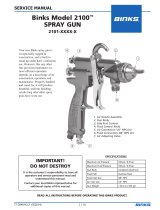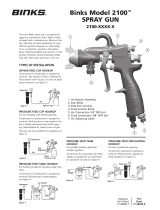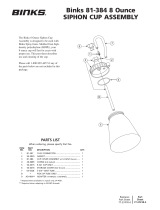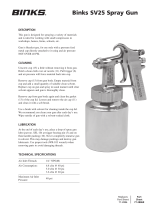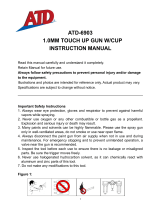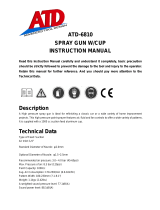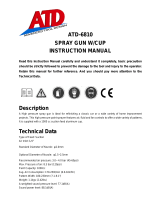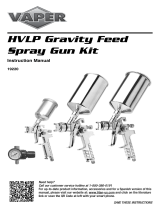Page is loading ...

77-3046-R7 (5/2019) 1 / 16 www.carlisleft.com
1. Air Nozzle Assembly
2. Gun Body
3. Side Port Control
4. Fluid Control Knob
5. Air Connection 1/4" NPS (m)
6. Fluid Connection 3/8" NPS (m)
7. Air Adjusting Valve
Your new Binks spray gun is
exceptionally rugged in
construction, and is built to
stand up under hard, continuous
use. However, like any other
fine precision instrument, its
most efficient operation
depends on a knowl edge of its
construction, operation, and
maintenance. Properly handled
and cared for, it will produce
beautiful, uniform finishing
results long after other spray
guns have worn out.
1
2
3
4
75
6
READ ALL INSTRUCTIONS BEFORE OPERATING THIS BINKS PRODUCT.
IMPORTANT!
DO NOT DESTROY
It is the customer's responsibility to have all
operators and service personnel read and
understand this manual.
Contact your local Binks representative for
additional copies of this manual.
SPECIFICATIONS
Maximum Air Pressure 100 psi / 6.9 bar
Maximum Fluid Pressure 100 psi / 6.9 bar
Gun Body Anodized Aluminum
Fluid Path Stainless Steel
Fluid Inlet Size 3/8" NPS
Air Inlet Size 1/4" NPS
Gun Weight 1 lb 6 oz / 635 gm
EN
SERVICE MANUAL
MODEL 2100™ SPRAY GUN
2101-XXXX-X

EN
77-3046-R7 (5/2019)2 / 16www.carlisleft.com
WARNING
!
In this part sheet, the words WARNING, CAUTION and NOTE are used to emphasize important safety information as follows:
CAUTION
Hazards or unsafe practices which could
result in minor personal injury, product
or property damage.
!
WARNING
Hazards or unsafe practices which could
result in severe personal injury, death or
substantial property damage.
!
NOTE
Important installation, operation or
maintenance information.
Read the following warnings before using this equipment.
FOR FURTHER SAFETY INFORMATION REGARDING BINKS AND DEVILBISS EQUIPMENT,
SEE THE GENERAL EQUIPMENT SAFETY BOOKLET (77-5300).
READ THE MANUAL
Before operating finishing equipment, read and
understand all safety, operation and maintenance
information provided in the operation manual.
AUTOMATIC EQUIPMENT
Automatic equipment may start suddenly without
warning.
INSPECT THE EQUIPMENT DAILY
Inspect the equipment for worn or broken parts
on a daily basis. Do not operate the equipment
if you are uncertain about its condition.
NEVER MODIFY THE EQUIPMENT
Do not modify the equipment unless the
manufacturer provides written approval.
KNOW WHERE AND HOW TO SHUT OFF THE
EQUIPMENT IN CASE OF AN EMERGENCY
PRESSURE RELIEF PROCEDURE
Always follow the pressure relief procedure in the
equipment instruction manual.
NOISE HAZARD
You may be injured by loud noise. Hearing
protection may be required when using this
equipment.
STATIC CHARGE
Fluid may develop a static charge that must be
dissipated through proper grounding of the
equipment, objects to be sprayed and all other
electrically conductive objects in the dispensing
area. Improper grounding or sparks can cause a
hazardous condition and result in fire, explosion
or electric shock and other serious injury.
FIRE AND EXPLOSION HAZARD
Never use 1,1,1-trichloroethane, methylene
chloride, other halogenated hydrocarbon solvents
or fluids containing such solvents in equipment
with aluminum wetted parts. Such use could
result in a serious chemical reaction, with the
possibility of explosion. Consult your fluid
suppliers to ensure that the fluids being used are
compatible with aluminum parts.
WEAR SAFETY GLASSES
Failure to wear safety glasses with side shields
could result in serious eye injury or blindness.
DE-ENERGIZE, DISCONNECT AND LOCK OUT ALL
POWER SOURCES DURING MAINTENANCE
Failure to De-energize, disconnect and lock out
all power supplies before performing equipment
maintenance could cause serious injury or death.
OPERATOR TRAINING
All personnel must be trained before operating
finishing equipment.
EQUIPMENT MISUSE HAZARD
Equipment misuse can cause the equip ment to
rupture, malfunction, or start unexpectedly and
result in serious injury.
KEEP EQUIPMENT GUARDS IN PLACE
Do not operate the equipment if the safety
devices have been removed.
PROJECTILE HAZARD
You may be injured by venting liquids or gases
that are released under pressure, or flying debris.
PINCH POINT HAZARD
Moving parts can crush and cut. Pinch points are
basically any areas where there are moving parts.

EN
77-3046-R7 (5/2019) 3 / 16 www.carlisleft.com
TYPES OF INSTALLATION
5/16" 1/4"
NOT RECOMMENDED
Only 34 PSI at gun inlet
25 feet of 1/4" I.D. hose causes
a drop of 26 PSI between the air
supply and the gun.
RECOMMENDED
48 PSI at gun inlet
25 feet of 5/16" I.D. hose causes
a drop of 12 PSI between the air
supply and the gun. For this
reason Binks recommends the use
of 5/16" hose.
WITH 60 PSI APPLIED AT AIR SUPPLY
AIR PRESSURE
Atomizing pressure must be set properly to allow for the drop in air pressure
between the regulator and the spray gun.
Cross section view
showing comparison of inside
hose diameters (actual size).
60 lbs. regulated pressure
An oil and water extractor
is important.
Achieving a fine spray
finish without the use of
a good oil and water
extractor is virtually
impossible.
A regulator/extractor
serves a double purpose.
It eliminates blistering and spotting by
keeping air free of oil and water, and it
gives precise air pressure control at the
gun.
Binks recommends using Model
HFRL-508 Oil and Water Separator /
Regulator. See your local distributor for
other models.
Air pressure for atomization is regulated at the extractor. The flow
of the fluid is adjusted by the fluid valve control knob on gun,
viscosity of paint and air pressure.
PRESSURE CUP HOOKUP
(Figure 1)
For fine finishing with limited spraying. Air pressure for
atomization is regulated at extractor; fluid pressure at cup
regulator. Pressure cup is also available less regulator.
PRESSURE TANK HOOKUP
(Figure 2)
For medium production spraying (single regulator). Air pressure
for atomization is regulated at extractor, fluid pressure at tank
regulator.
PRESSURE TANK WITH 2 REGULATORS
(Figure 3)
The pressure to the tank is regulated by the first regulator. The
pressure for atomization is regulated by the second regulator.
PRESSURE CIRCULATING HOOKUP
(Figure 4)
For heavy production spraying. Air pressure atomization regulated
at extractor. Fluid pressure regulated at fluid regulator.
SIPHON FEED HOOKUP
(Figure 5)
Air pressure for atomization is regulated at extractor. The amount
of fluid is adjusted by fluid control screw on gun, viscosity of
paint, and air pressure.
FIG 4
Fluid
Regulator
Oil & Water
Extractor
Air
Fluid
Return
Line
FIG 3
FIG 2
Air
Fluid
Outlet
Air
Inlet
Oil & Water
Extractor
Fluid
Pressure
Tank
Fluid Pressure Cup
FIG 1
Air
Cup Regulator
Oil & Water
Extractor
Oil & Water
Extractor
FIG 5
Air
Siphon Cup
Air Supply
Fluid
Pressure
Tank
Oil & Water
Extractor

EN
77-3046-R7 (5/2019)4 / 16www.carlisleft.com
In normal operation, the wings on
the nozzle are horizontal as
illustrated here. This provides
a vertical fan shaped pattern which
gives maximum
coverage as the
gun is moved
back and forth
parallel to the
surface being
finished.
Spray width adjustment: Turn clock-
wise for round, counterclockwise for fan.
Fluid control screw: Turn clockwise to
decrease flow, counterclockwise to
increase flow.
As width of spray is increased, more
material must be allowed to pass through
the gun to obtain the same coverage on
the increased area.
SIPHON SPRAYING
Set atomization pressure at approximate-
ly 50 PSI for lacquer and 60 PSI for
enamel. Test spray. If the spray is too
fine, reduce the air pressure or open fluid
control screw. If the spray is too coarse,
close the fluid control screw. Adjust the
pattern width and repeat adjustment of
spray if necessary.
PRESSURE SPRAYING
After selecting correct size fluid orifice,
set fluid pressure for desired flow. Open
atomization air and test spray. If spray is
too fine, reduce air pressure. If spray is
too coarse, raise air pressure. Adjust pat-
tern width and repeat adjustment of spray.
Keeping fluid control screw in open posi-
tion will reduce fluid needle wear.
The spray pattern of
the Binks gun is variable
from round to flat with
all patterns in between.
Spray width
adjustment
Fluid
control
screw
The first requirement for a good resultant finish is
the proper handling of the gun. The gun should be
held perpendicular to the surface being covered and
moved parallel with it. The stroke should be started
before the trigger is pulled and the trigger should
be released before the stroke is ended. This gives
accurate control of the gun and material.
The distance between gun and surface should be 6
to 12 inches depending on material and atomizing
pressure. The material deposited should always be
even and wet. Lap each stroke over the preceding
stroke to obtain a uniform finish.
NOTE
To reduce overspray and obtain maximum efficiency, always
spray with the lowest possible atomizing air pressure.
Coating should be even
and wet when spraying
Coating will
be light at
this point
Coating will
be heavy
at this point
Start
stroke
Pull
trigger
Release
trigger
End of
stroke
RIGHT
WRONG
TRAVEL OF GUN
6 to 12 inches
GUN HANDLING
It is extremely poor practice to mount the oil and
water extractor on or even near the compressor unit.
The temperature of the air is greatly increased as it
passes through the compressor and this compressed
air must be cooled before the moisture in it will
condense. If the air from the compressor is still
warm when it passes through the oil and water
extractor, moisture will not be effectively removed,
but will remain in suspension. Then, when the air
cools in the hose beyond the extractor, the moisture
will condense into drops of water and cause trouble.
Air lines must be properly drained
Pitch all air lines back towards the compressor so
that condensed moisture will flow back into the air
receiver where it can be removed by opening a
drain. Every low point on an air line acts as a water
trap. Such points should be fitted with an easily
accessible drain. See diagram.
AIR SUPPLY

EN
77-3046-R7 (5/2019) 5 / 16 www.carlisleft.com
FAULTY PATTERNS AND HOW TO CORRECT THEM
PATTERN CAUSE CORRECTION
Dried material around the
outside of the fluid nozzle tip
at position “C” restricts the
passage of atomizing air at
one point through the center
opening of air nozzle and
results in pattern shown.
This pattern can also be caused
by a loose air nozzle.
Dried material in side-port
“A” restricts passage of air.
Greater flow of air from
cleaner side-port “B” forces
fan pattern in direction of
clogged side.
Dissolve material in side-ports with thinner,
then blow gun clean. Do not poke into
openings with metal instruments.
Remove air nozzle and wipe off fluid tip
using rag wet with thinner. Tighten air
nozzle.
A split spray or one that is heavy on each
end of a fan pattern and weak in the
middle is usually caused by:
(1) Too high an atomization air pressure
(2) Attempting to get too wide a spray
pattern with thin material.
Reducing air pressure will correct cause (1).
To correct cause (2), open material control
to full position by turning to left. At the
same time, turn spray width adjustment to
right. This will reduce width of spray, but
will correct split spray pattern.
(1) Dried out packing around material
needle valve permits air to get into
fluid passageway. This results in
spitting.
(2) Dirt between fluid nozzle seat and
body or loosely installed fluid nozzle
will make gun spit.
(3) A loose or defective swivel nut on
siphon cup or material hose can cause
spitting.
To correct cause (1) back
up knurled nut (E), place
two drops of machine oil
on packing, replace nut
and tighten with fingers
only. In aggravated cases,
replace packing.
To correct cause (2), remove fluid nozzle (F),
clean back of nozzle and nozzle seat in gun
body using rag wet with thinner, replace
nozzle and draw up tightly against body.
To correct cause (3), tighten or replace
swivel nut.
E
F
G

EN
77-3046-R7 (5/2019)6 / 16www.carlisleft.com
❍ Available only as 5-Pack.
+ Indicates parts in 6-229 Repair Kit.
★
Alternate needle packing (optional) 54-747-5.
• Accessory item.
✔
Also available: Heavy Duty Spring 54-1372, not furnished. Please order separately.
* Be sure to specify number stamped on air nozzle and fluid nozzle, or see Nozzle
Selection Chart.
1 — 2100 GUN BODY (NOT SOLD SEPARATELY) ........ 1
2 54-3347 SIDE PORT CONTROL ASSEMBLY ......... 1
3 54-1013 MATERIAL BODY ................................... 1
4 2-28-5❍
+★
PTFE PACKING ....................................... 1
5 56-164 PACKING NUT ........................................ 1
6 54-5464 2100 TRIGGER ....................................... 1
7 20-5285-5❍
+
O-RING VITON ....................................... 1
8 54-750-5❍
+
SPRING ................................................... 1
9 54-1236 AIR VALVE ASSEMBLY ........................... 1
10 SGK-457-K AIR ADJUSTMENT VALVE ..................... 1
11 54-768 AIR CONNECTION ................................. 1
12 *
SEE FOOTNOTE
AIR NOZZLE ........................................... 1
13 54-918-5❍
+
GASKET .................................................. 1
14 *
SEE FOOTNOTE
FLUID NOZZLE ....................................... 1
15 *
SEE FOOTNOTE
FLUID NEEDLE ....................................... 1
16 54-1347-5❍
+✔
SPRING ................................................... 1
17 54-1007 CONTROL SCREW .................................. 1
18 54-304-5❍
+
SPRING ................................................... 1
19 20-3757
+
O-RING ................................................... 1
20 54-738-5❍
+
PACKING ................................................ 2
21 54-1014-5❍
+
PIN .......................................................... 1
22 54-1025
+
VALVE STEM ASSEMBLY ....................... 1
23 82-126-5❍ SCREW ................................................... 1
24 82-135-5❍ NUT ........................................................ 1
25 82-158-5❍
+
PACKING ................................................ 1
26 54-1780• QUICK CHANGE SIDEPORT CONTROL .. 1
(SOLD SEPARATELY AS ASSEMBLY)
27 JGA-132• PLUG (SOLD SEPARATELY) .................... 1
28 82-469 ROUND BRUSH ...................................... 1
29 OMX-88 FLAT BRUSH ........................................... 1
30 54-1020 STUD ...................................................... 1
31 54-1010 VALVE BODY ......................................... 1
32 54-1016-5 WASHER ................................................ 2
33 54-1015-5 WASHER ................................................ 1
34 5-476 FLUID NOZZLE WRENCH ....................... 1
ITEM PART
NO. NO. DESCRIPTION QTY.
ITEM PART
NO. NO. DESCRIPTION QTY.
PARTS LIST
When ordering, please specify Part No.
Binks MODEL 2100
™
SIPHON SPRAY GUN
1
11
10
6
23
27
30
9
5
4
28
29
CAUTION
The fluid inlet is not meant to
be removed or replaced.
!
13
14
12
8
22
19
25
24
31
7
3
15
16
17
26
2
18
21
33
34
20
32

EN
77-3046-R7 (5/2019) 7 / 16 www.carlisleft.com
When used with a cup, thinner or suitable
solvent should be siphoned through gun
by inserting tube in open container of
that liquid. Move trigger constantly to
thoroughly flush passageway and to clean
tip of needle.
CLEANING GUN USED WITH
PRESSURE TANK
Shut off the air supply to the tank and
release the pressure on the tank. Open
vent and loosen air nozzle. Hold a piece
of cloth, wadded in the hand over the air
nozzle and pull the trigger, the air will
back up through the fluid nozzle, and
force the fluid out of the hose into the
tank. Next put enough thinner into the
tank to wash the hose and gun thorough-
ly and spray this through the gun until it
is clean. Then blow out the fluid hose to
dry it and remove all traces of materials
by attaching it to the air line.
THINNER
Keep thinner level below packing.
It is extremely poor practice to place an
entire gun in thinner. When this is done,
the solvent dissolves the oil in the leath-
er packing and causes the gun to spit. It
is good practice to place the nozzle and
fluid connection in thinner. Vessel used
should be shallow enough to prevent
thinner from reaching packing.
LUBRICATION
Daily oil fluid needle packing, air valve
packing, and trigger bearing screw.
Occasionally coat needle valve spring
with petroleum jelly. OIL ALL
WORKING PARTS EVERY DAY.
CONTROLLING THE FAN SPRAY: The
fan spray for an external mix nozzle set-
up is easily controlled by means of the
side port control (2). Turning this control
to the right, or clockwise, until it is
closed will give a round spray; turning it
to the left, or counter-clockwise, will
widen the spray into a fan shape of any
width desired. The direction of the fan
spray, either horizontal or vertical, is
obtained by turning the air nozzle to the
desired position, then tightening the
retainer ring.
CONTROLLING THE FLUID
If a fluid pressure tank is used, the
amount of fluid can be controlled by reg-
ulating the pressure on the tank. The
amount of fluid can also be controlled by
means of the fluid control screw (17).
Turning this screw to the right, or clock-
wise, reduces the amount of fluid; to the
left, or counter-clockwise, increases the
amount of fluid.
FAULTY SPRAY
A faulty spray is caused by improper
cleaning or dried material around the
fluid nozzle tip or in the air nozzle. Soak
these parts in a solvent that will soften
the dried material and remove with a
brush or cloth.
If either the air nozzle or fluid nozzle is
damaged, the part must be replaced
before a perfect spray can be obtained.
TO REPLACE THE FLUID PACKING:
Remove the fluid control screw (17),
spring (16) and needle. Then remove the
fluid packing nut (5) and take out the old
packings with a small stiff wire. Replace
with new packings (4) oiled lightly and
assemble in reverse order. To set pack-
ing, insert needle, tighten nut until the
needle begins to be too stiff for the
spring to move the needle. Then loosen
nut 1/2 to 3/4 turn.
CORRECTING AIR LEAK
THROUGH GUN
Air leaking through the gun is caused by
the valve stem assembly (22), not seating
properly against the valve body (31).
Remove the valve body (31) and valve
stem assembly (22). Thoroughly clean
parts and inspect for damage. Replace
worn or damaged parts and assemble in
reverse order.
CORRECTING AIR LEAK AROUND
AIR VALVE STEM
Air leaking around the air valve stem (22)
may be caused by worn packings (25) or
damaged air valve stem (22). Remove
trigger (6), packing nut (24) and pack-
ings (25). Clean extended portion of air
valve stem (22) and inspect for damage;
if stem is damaged, replace same as
above, insert new packings and assemble
in reverse order.
Binks MODEL 2100
™
SIPHON SPRAY GUN – POINTERS ON CLEANING
Keep thinner
level below
packing
Thinner
➧
CAUTION
Never use metal instruments to clean
the air or fluid nozzles. These parts
are carefully machined and any dam-
age to them will cause a faulty spray.
!

EN
77-3046-R7 (5/2019)8 / 16www.carlisleft.com
Binks MODEL 2100
™
SPRAY GUN – GENERAL MAINTENANCE
SPRAY GUN
1. Immerse only the front end of the
gun until solvent just covers the fluid
connection.
2. Use a bristle brush and solvent to
wash off accumulated paint.
3. Do not submerge the entire spray gun
in solvent because:
a. the lubricant on the packings will
dissolve and the packings will
dry out.
b. the lubricant at wear surfaces will
dissolve causing harder operation
and faster wear.
c. residue from dirty solvent may
clog the narrow air passages in
the gun.
4. Wipe down the outside of the gun
with solvent-dampened rag.
5. Lubricate gun daily. Use a light
machine oil on:
a. fluid needle packing.
b. air valve packing.
c. side port control packing.
d. trigger pivot point.
Coat the fluid control spring with
vaseline.
AIR NOZZLE, FLUID NOZZLE,
FLUID NEEDLE
1. All nozzles and needles are precision
made. They should be handled with
care.
2. Do not make any alterations in the
gun. To do so could cause finishing
difficulties.
3. To clean nozzles, soak them in sol-
vent to dissolve any dried material,
then blow them clean with air.
4. Do not probe any of the holes in the
nozzles with metal instruments. If
probing is necessary, use only a tool
that is softer than brass.
CAUTION
Never use lubricants contaning sili-
cone. This material may cause finish
defects.
!
A. Material to Be Sprayed
Select the type of fluid you want to
spray or a fluid which has the same
characteristics as one of those listed.
B. Method of Feeding Material to
the Gun
Fluid Nozzle—Consider the speed of
application and the viscosity of the
fluid to be sprayed. Referring to the
Fluid Nozzle Orifice Size Chart,
those fluid nozzles which can be
changed within an air nozzle are
indicated.
Air Nozzle—Choice is determined by
the type of fluid to be sprayed and the
volume of air available for the gun.
—External Mix Nozzles, which are
generally used, accomplish atomiza-
tion outside the nozzle. Spray pat-
terns are adjustable from round to fan
with all intermediate patterns.
(Designated by the letter “E”).
Siphon Type External Mix Nozzles,
designated by the letter “S”, will
siphon the material from a cup. Used
generally for refinishing and touch-up
work which does not require large
quantities of paint.
Pressure Type External Mix Nozzles,
designated by the letter “P”, require
pressure to feed the material to the
nozzle. A pressure cup, pressure tank
or pump is necessary. Used for pro-
duction work and where large quanti-
ties of fluid are handled. This type of
nozzle has a greater range of fluid
flow and does not limit the size of
the paint container.
—Internal Mix Nozzles mix the air
and fluid within the air nozzle. The
spray pattern is determined by the
shape of the nozzle and cannot be
changed. Internal mix nozzles require
less air and produce slightly less fog.
Pressure equipment must be used
with this type of nozzle.
Recommended for maintenance
spraying of heavy materials where a
fine finish is not required.
(Designated by the letter “I”).
C. Volume of Air (CFM required)
The cubic feet per minute (CFM)
listed at 30, 50 and 70 PSI is the
actual air used by the air nozzle.
Increase of pressure subsequently
increases volume of air required by
air nozzle, or vice versa. Assume that
a compressor will produce 3-5 CFM
per horsepower.
NOZZLE SELECTION
(See chart on pages 10-11)
NOTE
All parts on a spray gun should be
screwed in hand tight at first; this will
avoid the possibility of cross threading
the parts. If the parts can not be
turned by hand easily, make sure you
have the correct parts, unscrew,
realign, and try again. NEVER use
undue force in mating parts.
NOTE
The greater the air consumption, the
faster the fluid may be applied or the
finer a given amount of fluid can be
atomized.
CAUTION
Never unscrew the fluid inlet nipple!
(Item 6, front page.) It is not meant to
be removed or replaced.
!

EN
77-3046-R7 (5/2019) 9 / 16 www.carlisleft.com
2101-0000-0 2100 GUN LESS SET-UP
2101-2800-0 2100 GUN 63BSS LESS AIR NOZZLE
2101-2800-7 2100 GUN 63BSS-63PB (P)
2101-2808-2 2100 GUN 63BSS-66SD-3
2101-2821-3 2100 GUN 63BSS-21MD-3 (P)
2101-3100-0 2100 GUN 63CSS LESS AIR NOZZLE
2101-4300-0 2100 GUN 66SS LESS AIR NOZZLE
2101-4300-7 2100 GUN ASSEMBLY (66SS-63PB)
2101-4307-5 2100 GUN 66SS-66S (S)
2101-4307-9 2100 GUN 66SS-66SD (S)
2101-4308-2 2100 GUN 66SS-66SD-3
2101-4308-8 2100 GUN 66SS-66SK (S)
2101-4314-9 2100 GUN 66SS-200 AIR CAP
2101-4321-1 2100 GUN 66SS-21MD-1 (S)
2101-4321-2 2100 GUN 66SS-21MD-2 (S)
2101-4800-0 2100 GUN 67SS LESS AIR NOZZLE
2101-4909-5 2100 GUN 67VT-67PB (P)
2101-5100-0 2100 GUN 68SS LESS AIR NOZZLE
2101-5111-5 2100 GUN 68SS-68PB (P)
2101-5200-0 2100 GUN 68VT LESS AIR NOZZLE
2101-6260-0 2100 GUN 63SS-63P
2101-8000-0 2100 GUN 59ASS LESS AIR NOZZLE
2101-8200-0 2100 GUN 59CSS LESS AIR NOZZLE
COMPLETE GUN ASSEMBLIES AVAILABLE

EN
77-3046-R7 (5/2019)10 / 16www.carlisleft.com
TYPE OF FLUID TO BE SPRAYED FLUID NOZZLE
ORIFICE
SIZE
IN [mm] AIR NOZZLE ADDITIONAL PARTS
VERY THIN
14–16 Sec.—No. 2 Zahn
Wash Primers, Dyes, Stains, Solvents,
Water, Inks
45-6301 (63SS) .028 [0.8] 46-6000 (63P)
45-6311 (63ASS) .040 [1.1] 46-6000 (63P)
45-6321 (63BSS) .046 [1.2] 46-6002 (63PB)
45-6601 (66SS) .070 [1.8] 46-6018 (66S)
45-6601 (66SS) .070 [1.8] 46-6020 (66SD)
45-6601 (66SS) .070 [1.8] 46-6082 (66SK)
45-6321 (63BSS) .046 [1.2] 46-2200 (200) 54-4512 BASE & RING
VERY THIN TO MEDIUM
14–30 Secs. — No. 2 Zahn
NOTE: 21MD-1 AND 21MD-2 AIR CAPS CAN SPRAY WITH PRESSURE
SET-UPS PRODUCING SPRAY PATTERS APPROX. 12” WIDE.
45-6601 (66SS) .070 [1.8] 46-21MD-1 (21MD-1)
45-6601 (66SS) .070 [1.8] 46-21MD-2 (21MD-2)
45-6701 (67SS) .086 [2.2] 46-21MD-2 (21MD-2)
45-6321 (63BSS) .046 [1.2] 46-21MD-3 (21MD-3)
THIN
16–20 Secs. — No. 2 Zahn
Sealers, Primers, Lacquers, Inks,
Lubricants, Zinc Chromates, Acrylics
45-6311 (63ASS) .040 [1.1] 46-6000 (63P)
45-6601 (66SS) .070 [1.8] 46-6082 (66SK)
45-6321 (63BSS) .046 [1.2] 46-2200 (200) 54-4512 BASE & RING
45-6331 (63CSS) .052 [1.3]
MEDIUM
19–30 Secs. — No. 2 Zahn
Lacquers, Syn. Enamels, Varnishes,
Shellacs, Fillers, Primers, Epoxies,
Urethanes, Lubricants, Wax Emulsions
45-6321 (63BSS) .046 [1.2] 46-6002 (63PB)
45-6331 (63CSS) .052 [1.3] 46-6079 (63PR)
45-6601 (66SS) .070 [1.8] 46-6020 (66SD)
45-6601 (66SS) .070 [1.8] 46-6082 (66SK)
45-6331 (63CSS) .052 [1.3] 46-2200 (200) 54-4512 BASE & RING
45-6601 (66SS) .070 [1.8]
HIGH SOLIDS
Enamels 45-6601 (66SS) .070 [1.8] 46-6079 (63PR)
HEAVY (CREAM-LIKE)
Over 28 Secs. — No. 4 Ford
House Paint, Wall Paint (Oil, Latex),
Block Sealers, Mill Whites, Vinyls, Acrylics,
Epoxies, Gel Coats
45-6701 (67SS) .086 [2.2] 46-6026 (67PB)
45-6801 (68SS) .110 [2.8] 46-6032 (68PB)
VERY HEAVY
Unaggregated, Block Fillers,
Textured Coatings, Fire Retardants,
Road Marking Paint, Bitumastics,
Cellular Plastisols, Underbody, Roof Coatings
45-6801 (68SS) .110 [2.8] 46-6032 (68PB)
45-5911 (59ASS) .171 [4.3] 46-2244 (244) 54-2065 RING
45-5912 (59BSS) .218 [5.5] 46-2250 (250) 54-2065 RING
45-5912 (59BSS) .218 [5.5] 46-2252 (252) 54-2065 RING
45-5913 (59CSS) .281 [7.1] 46-2262 (262) 54-2065 RING
ADHESIVES
Waterbase — White Vinyl Glue
Solvent Base — Neoprenes (Contact Cements)
45-6331 (63CSS) .052 [1.3] 46-6002 (63PB)
45-6601 (66SS) .070 [1.8] 46-6079 (63PR)
45-6701 (67SS) .086 [2.2] 46-6026 (67PB)
45-6301 (63SS) .028 [0.8] 46-6092 (66SD-3)
45-6311 (63ASS) .040 [1.1] 46-6092 (66SD-3)
45-6321 (63BSS) .046 [1.2] 46-6092 (66SD-3)
45-6601 (66SS) .070 [1.8] 46-6092 (66SD-3)
45-6601 (66SS) .070 [1.8] 46-6103 (66SDJG)
45-6601 (66SS) .070 [1.8] 46-6041 (66R)
45-6601 (66SS) .070 [1.8] 46-6103 (66SDJG)
45-6605 (L6SS) .070 [1.8] 46-6061 (63PH-1)
CERAMICS &
SIMILAR ABRASIVE MATERIALS
Glazes, Engobes, Porcelain Enamel
45-6402 (64VT) .064 [1.6] 46-6007 (64PA)
45-6702 (67VT) .086 [2.2] 46-6028 (67PD)
45-6802 (68VT) .110 [2.8] 46-6032 (68PB)
CONCRETE CURING COMPOUNDS 45-6601 (66SS) .070 [1.8] 46-2200 (200) 54-4512 BASE & RING
MULTICOLOR PAINTS 45-6601 (66SS) .070 [1.8] 46-2200 (200) 54-4512 BASE & RING
45-6801 (68SS) .110 [2.8] 46-2201 (201) 54-4512 BASE & RING
45-6801 (68SS) .110 [2.8] 46-2205 (206) 54-4512 BASE & RING
NON-STICK COATINGS 45-6311 (63ASS) .040 [1.1] 46-6002 (63PB)
45-6321 (63BSS) .046 [1.2] 46-6079 (63PR)
45-6601 (66SS) .070 [1.8] 46-6020 (66SD)
HAMMERS 45-6331 (63CSS) .052 [1.3] 46-6002 (63PB)
45-6601 (66SS) .070 [1.8] 46-6002 (63PB)
45-6601 (66SS) .070 [1.8] 46-6020 (66SD)
WRINKLE ENAMELS 45-6331 (63CSS) .052 [1.3] 46-6002 (63PB)
45-6601 (66SS) .070 [1.8] 46-6002 (63PB)
ZINC RICH COATINGS 45-6702 (67VT) .086 [2.2] 46-6026 (67PB)
NOZZLE SELECTION CHART
(CONTINUES ON NEXT PAGE)

EN
77-3046-R7 (5/2019) 11 / 16 www.carlisleft.com
All air nozzles shown in combination with these (+) fluid nozzles can also be used in combination with any other fluid nozzle marked (+)
*See text Section B, page 8, for type code. ★All standard needles listed are stainless steel.
TYPE OF FLUID TO BE SPRAYED
FLUID
NEEDLE NO. ★ TYPE*
CFM [L/m] @
PATTERN @
8 IN [203 mm]
30 PSI
[2.1 BAR]
50 PSI
[3.4 BAR]
70 PSI
[4.8 BAR]
IN [mm]
VERY THIN
14–16 Sec.—No. 2 Zahn
Wash Primers, Dyes, Stains, Solvents,
Water, Inks
47-56300 (563) PE 4.5 [127.4] 7.5 [212.3] 10.0 [283.1] 5.0 [127.0]
47-56310 (563A) PE 5.1 [144.4] 8.7 [246.3] 12.2 [345.4] 11.0 [279.4]
47-56310 (563A) PE 9.0 [254.8] 14.3 [404.9] 20.0 [566.3] 14.0 [355.6]
47-56500 (565) SE 3.4 [96.27] 5.0 [141.5] 9.0 [228.6]
47-56500 (565) SE 7.9 [223.7] 12.1 [342.6] 10.5 [266.7]
47-56500 (565) SE 11.0 [311.4] 15.2 [430.4] 19.5 [552.1] 13.0 [330.2]
47-56310 (563A) PI 3.1 [87.78] 5.2 [147.2] 6.4 [181.2] 12.0 [304.8]
VERY THIN TO MEDIUM
14–30 Secs. — No. 2 Zahn
NOTE: 21MD-1 AND 21MD-2 AIR CAPS CAN SPRAY WITH PRESSURE
SET-UPS PRODUCING SPRAY PATTERS APPROX. 12” WIDE.
47-56500 (565) SE 12.0 [339.8] 17.3 [489.8] 23.0 [651.2] 11.0 [279.4]
47-56500 (565) SE 15.2 [430.4] 22.2 [628.6] 29.6 [838.1] 11.0 [279.4]
47-56700 (567) SE 12.5 [353.9] 18.3 [518.1] 24.4 [690.9] 13.0 [330.2]
47-56310 (563A) PE 11.6 [328.4] 16.6 [470.0] 22.2 [628.6] 16.0 [406.4]
THIN
16–20 Secs. — No. 2 Zahn
Sealers, Primers, Lacquers, Inks,
Lubricants, Zinc Chromates, Acrylics
47-56310 (563A) PE 5.1 [144.4] 8.7 [246.3] 12.2 [345.4] 11.0 [279.4]
47-56500 (565) SE 11.0 [311.4] 15.2 [430.4] 19.5 [552.1] 13.0 [330.2]
47-56310 (563A) PI 3.1 [87.78] 5.2 [147.2] 6.4 [181.2] 12.0 [304.8]
47-56310 (563A) PI 3.9 [110.4] 5.5 [155.7] 7.4 [209.5] 9.0 [228.6]
MEDIUM
19–30 Secs. — No. 2 Zahn
Lacquers, Syn. Enamels, Varnishes,
Shellacs, Fillers, Primers, Epoxies,
Urethanes, Lubricants, Wax Emulsions
47-56310 (563A) PE 9.0 [254.8] 14.3 [404.9] 20.0 [566.3] 14.0 [355.6]
47-56310 (563A) PE 9.5 [269.0] 15.5 [438.9] 19.5 [552.1] 18.0 [457.2]
47-56500 (565) SE 7.9 [223.7] 12.0 [339.8] 11.0 [279.4]
47-56500 (565) SE 11.0 [311.4] 15.2 [430.4] 19.5 [552.1] 13.0 [330.2]
47-56310 (563A) PI 3.1 [87.78] 5.2 [147.2] 6.4 [181.2] 12.0 [304.8]
47-56500 (565) PI 3.9 [110.4] 5.5 [155.7] 7.4 [209.5] 9.0 [228.6]
HIGH SOLIDS
Enamels 47-56500 (565) PE 9.5 [269.0] 15.5 [438.9] 19.5 [552.1] 18.0 [457.2]
HEAVY (CREAM-LIKE)
Over 28 Secs. — No. 4 Ford
House Paint, Wall Paint (Oil, Latex),
Block Sealers, Mill Whites, Vinyls, Acrylics,
Epoxies, Gel Coats
47-56700 (567) PE 9.5 [269.0] 14.9 [421.9] 19.5 [552.1] 12.0 [304.8]
47-56800 (568) PE 9.5 [269.0] 14.1 [399.2] 19.1 [540.8] 12.0 [304.8]
VERY HEAVY
Unaggregated, Block Fillers,
Textured Coatings, Fire Retardants,
Road Marking Paint, Bitumastics,
Cellular Plastisols, Underbody, Roof Coatings
47-56800 (568) PE 9.5 [269.0] 14.1 [399.2] 19.1 [540.8] 12.0 [304.8]
47-55900 (559) PI 7.8 [220.8] 11.5 [325.6] 15.2 [430.4] 12.0 [304.8]
47-55900 (559) PI 7.3 [206.7] 11.0 [311.4] 14.7 [416.2] Round
47-55900 (559) PI 7.8 [220.8] 11.5 [325.6] 15.2 [430.4] 6.0 [152.4]
47-55900 (559) PI 7.3 [206.7] 11.0 [311.4] 14.7 [416.2] 6.0 [152.4]
ADHESIVES
Waterbase — White Vinyl Glue
Solvent Base — Neoprenes (Contact Cements)
47-56310 (563A) PE 9.0 [254.8] 14.3 [404.9] 20.0 [566.3] 14.0 [355.6]
47-56500 (565) PE 9.5 [269.0] 15.5 [438.9] 19.5 [552.1] 15.0 [381.0]
47-56700 (567) PE 9.5 [269.0] 14.1 [399.2] 19.1 [540.8] 12.0 [304.8]
47-56300 (563) PE 10.4 [294.4] 15.4 [436.0] 20.4 [577.6] 9.0 [228.6]
47-56310 (563A) PE 10.4 [294.4] 15.4 [436.0] 20.4 [577.6] 9.0 [228.6]
47-56310 (563A) PE 10.4 [294.4] 15.4 [436.0] 20.4 [577.6] 11.0 [279.4]
47-56500 (565) PE 14.2 [402.0] 21.2 [600.3] 20.4 [577.6] 10.0 [254.0]
47-56500 (565) PE 10.4 [294.4] 9.0 [228.6]
47-56500 (565) PE / SE 4.2 [118.9] Round
47-56500 (565) PE 10.4 [294.4] 9.0 [228.6]
47-56500 (565) PE 9.5 [269.0] 14.2 [402.0] 19.0 [538.0] 18.0 [457.2]
CERAMICS &
SIMILAR ABRASIVE MATERIALS
Glazes, Engobes, Porcelain Enamel
47-57402 (574VT) PE 12.1 [342.6] 15.0 [424.7] 21.0 [594.6] 13.0 [330.2]
47-57702 (577VT) PE 10.0 [283.1] 15.0 [424.7] 20.0 [566.3] 15.0 [381.0]
47-57802 (578VT) PE 9.5 [269.0] 14.1 [399.2] 19.1 [540.8] 12.0 [304.8]
CONCRETE CURING COMPOUNDS 47-56500 (565) PI 3.1 [87.78] 5.2 [147.2] 6.4 [181.2] 15.0 [381.0]
MULTICOLOR PAINTS 47-56500 (565) PI 3.1 [87.78] 5.2 [147.2] 15.0 [381.0]
47-56800 (568) PI 6.8 [192.5] 11.0 [279.4]
47-56800 (568) PI 9.8 [277.5] 15.0 [381.0]
NON-STICK COATINGS 47-56310 (563A) PE 9.0 [254.8] 14.3 [404.9] 20.0 [566.3] 10.0 [254.0]
47-56310 (563A) PE 9.5 [269.0] 15.5 [438.9] 19.5 [552.1] 15.0 [381.0]
47-56500 (565) SE 7.9 [223.7] 12.1 [342.6] 7.0 [177.8]
HAMMERS 47-56310 (563A) PE 9.0 [254.8] 14.3 [404.9] 14.0 [355.6]
47-56500 (565) PE 9.0 [254.8] 14.3 [404.9] 14.0 [355.6]
47-56500 (565) SE 7.9 [223.7] 12.1 [342.6] 7.0 [177.8]
WRINKLE ENAMELS 47-56310 (563A) PE 9.0 [254.8] 14.3 [404.9] 20.0 [566.3] 10.0 [254.0]
47-56500 (565) PE 9.0 [254.8] 14.3 [404.9] 20.0 [566.3] 10.0 [254.0]
ZINC RICH COATINGS 47-57702 (577VT) PE 9.5 [269.0] 14.1 [399.2] 19.1 [540.8] 12.0 [304.8]
NOZZLE SELECTION CHART
(CONTINUED FROM PREVIOUS PAGE)

EN
77-3046-R7 (5/2019)12 / 16www.carlisleft.com
SPECIAL NOZZLES – INTERNAL MIX HEAVY MATERIAL
FLUID
NOZZLE
AIR NOZZLES
250, 252, 262
#54-2065
RING
#559 NEEDLE
ASSEMBLY
GUIDE
SCREW
SPECIAL NOZZLES – INTERNAL MIX HEAVY MATERIAL
47-56800
NEEDLE ASSEMBLY
54-372
NOZZLE BASE RING
709 SS
AIR NOZZLE TIP
68 SS
FLUID NOZZLE
#54-928 10" CLEANING ATTACHMENT
(REQUIRED FOR DEGREASING AND LUBRICATING)
SPECIAL NOZZLE – CLEANING
MULTI-COLOR CONVERSION KIT FOR 60 SERIES NOZZLES & 200 SERIES TIPS
#54-1584 RING*(USED WITH 200 SERIES TIPS ONLY).
#54-1583 BASE*
66SS / 67SS / 68SS FLUID NOZZLE NEEDLE ASSEMBLY200 SERIES TIPS
*
54-4512 KIT TO CONVERT
FROM STANDARD SET-UP
TO MULTI-COLOR

EN
77-3046-R7 (5/2019) 13 / 16 www.carlisleft.com
HAV-500 OR HAV-501
Adjusting Valve
(HAV-501 SHOWN)
HAV-500 does not have
pressure gauge. Use to control
air usage at gun.
6-429 Binks
Gunners
Mate Lube
(Twenty
2 oz. bottles)
Compatible with all
paint materials; con-
tains no silicone or
petroleum distillates to
contaminate paint. SDS
available upon request.
NIOSH-Certied, for respiratory protection
in atmospheres not immediately danger-
ous to life.
Small Medium Large
40-141 40-128 40-143
Millennium 3000
Twin Cartridge
Paint Spray Respirator
192212 Professional Spray Gun
Cleaning Kit
Contains six precision tools designed to eectively clean
all DeVilbiss, Binks, Finishline and other brand spray guns.
ACCESSORIES
HAF-507
Whirlwind™
In-Line Air Filter
Kit of 12
Removes water, oil, and debris
from the air line.
29-3100 Scrubs
®
Hand Cleaner Towels
Scrubs
®
are a premoistened
hand cleaner towel for painters,
body men and mechanics that
go where you go and no water
is needed.
TGC-545
1 Qt. Siphon Cup
(Aluminum)
3/8" nps thread for full size guns.
DPC-69-K1
3/8 NPS Siphon Cup
Adapter Kit
DeKups
®
Accessories for siphon feed cups
SHELLS LINERS

EN
77-3046-R7 (5/2019)14 / 16www.carlisleft.com
NOTES

EN
77-3046-R7 (5/2019) 15 / 16 www.carlisleft.com
NOTES

EN
77-3046-R7 (5/2019)16 / 16www.carlisleft.com
WARRANTY POLICY
This product is covered by Carlisle Fluid Technologies’ materials and workmanship limited warranty.
The use of any parts or accessories, from a source other than Carlisle Fluid Technologies,
will void all warranties. Failure to reasonably follow any maintenance guidance provided
may invalidate any warranty.
For specic warranty information please contact Carlisle Fluid Technologies.
For technical assistance or to locate an authorized distributor,
contact one of our international sales and customer support locations.
Region Industrial/Automotive Automotive Renishing
Americas
Tel: 1-800-992-4657 Tel: 1-800-445-3988
Fax: 1-888-246-5732 Fax: 1-800-445-6643
Europe, Africa,
Middle East, India
Tel: +44 (0)1202 571 111
Fax: +44 (0)1202 573 488
China
Tel: +8621-3373 0108
Fax: +8621-3373 0308
Japan
Tel: +81 45 785 6421
Fax: +81 45 785 6517
Australia
Tel: +61 (0) 2 8525 7555
Fax: +61 (0) 2 8525 7575
Carlisle Fluid Technologies is a global leader in innovative nishing technologies.
Carlisle Fluid Technologies reserves the right to modify equipment specications without prior notice.
DeVilbiss
®
, Ransburg
®
, ms
®
, BGK
®
, and Binks
®
are registered trademarks of Carlisle Fluid Technologies, Inc.
©2019 Carlisle Fluid Technologies, Inc.
All rights reserved.
For the latest information about our products, visit www.carlisleft.com
/

